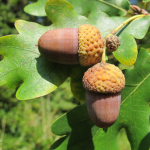Carvalho-alvarinho
(Quercus robur)
Família: Fagaceae
Esta árvore de folha caduca é uma das mais características do Vale do Lourêdo. Pode atingir os 45 metros de altura e tem uma copa alta e larga, com forma irregular. A casca do tronco é lisa quando os carvalhos são jovens e, à medida que a árvore cresce, vão aparecendo mais fendas e a cor castanha vai escurecendo. As folhas são pinatilobadas de cor verde clara, ficando castanho-alaranjadas no outono. Uma das características mais distintivas do carvalho é o seu fruto castanho-claro, com cúpula e de casca grossa, a bolota. Outra estrutura esférica que se pode observar frequentemente nos carvalhos, muitas vezes confundido como fruto, é o bugalho. Os bugalhos são galhas, estruturas que se formam na planta como resposta a agressões externas, tais como picadas de insetos ou ataque de fungos, bactérias ou nemátodos. Nos carvalhos, é frequente a ocorrência de bugalhos causada pela picada de insetos himenópteros, ou seja, do grupo das vespas, abelhas e formigas.
É a árvore dominante dos carvalhais, também chamados de reboredos, roboredos ou robledos, ocorrendo abundantemente em vários tipos de bosques de árvores caducifólias. Encontra-se, geralmente, em zonas de clima temperado com solos húmidos, sendo um indicador de humidade do solo. Embora prefira áreas com elevada precipitação anual, pode apresentar resistência a alguns períodos de seca. Em Portugal ocorre maioritariamente no noroeste.
O carvalho-alvarinho é uma espécie com elevada importância ecológica, sendo uma peça fulcral no habitat de inúmeras espécies de fauna. Serve de abrigo para várias espécies de invertebrados, que vivem nas folhas, no tronco e nas bolotas, e, no caso de árvores mais velhas, para várias espécies de vertebrados que se abrigam nos buracos dos troncos. É uma fonte de alimento para inúmeras espécies, sendo que existem invertebrados que se alimentam das suas folhas e as suas bolotas são um recurso alimentar muito importante para inúmeros vertebrados, tais como pequenos mamíferos e algumas aves. É também uma árvore muito resistente a fogos, devido à sua casca espessa, sendo de extrema importância no controlo dos incêndios florestais.
Outros nomes comuns: carvalho-comum, carvalho-roble, carvalho-vermelho.



